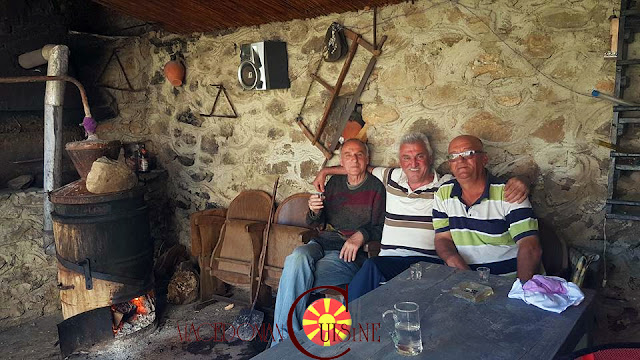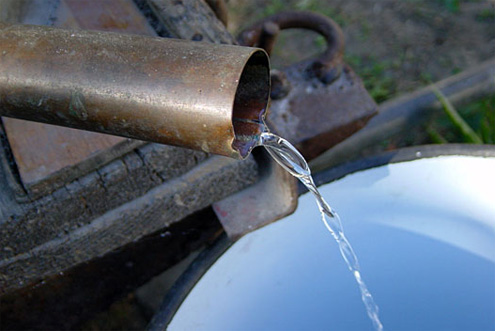Home production of brandy (rakija) is a tradition in Macedonia. In order to receive high quality grape and fruit brandy, producers should be very careful with the technology and manufacturing process.
Thе process of fermenting the grapes (cleared from vine stems and leaves) lasts at least 60 days in warmer days, while later in the autumn, that process lasts longer. Now, when the grapes would "lie" at the bottom of the barrel, means that they are fermented. According to the old master, in recent times, rather than wait for weeks, wine yeast was added that made the grapes ferment faster and all bacteria were destroyed. Yet most important of all is if the grapes have sugar; if there is sugar, there will be more brandy, and therefore the wine cellars don't purchase grapes with more sugar because it is not so good for making wine.
When the process of boiling is finished and grape becomes komina, the cauldron for making brandy is set. The complete equipment for making brandy is consisted of a copper pot and pot that differs from the barrel for having no lid, and it must constantly have cold water inside so by cooling, condensation can be turned into liquid alcohol. Both containers are connected with a pipe where the condensed liquid from the one container is transferred to the other container filled with cold water.
 |
| Rakija - connecting people |
When the process of boiling is finished and grape becomes komina, the cauldron for making brandy is set. The complete equipment for making brandy is consisted of a copper pot and pot that differs from the barrel for having no lid, and it must constantly have cold water inside so by cooling, condensation can be turned into liquid alcohol. Both containers are connected with a pipe where the condensed liquid from the one container is transferred to the other container filled with cold water.
 |
| Set for making rakija |
To obtain a quality brandy, follow these important rules:
1. Fruits from the fruit trees and grapes should be harvested at full maturity and shoudn't be rotten.
2. Containers where blended grapes or fruits are put should be wooden or plastic for food purposes. We should not use plastic containers that are used for storage and transmission of technical materials such as plastics which affect human health.
3. Before use, containers should be well cleaned, wooden pots are cleaned with hot water and wooden soda and plastic containers are cleaned with appropriate detergent and rinsed well. Very good cleaning of the tank is achieved with a solution of salt in quantities of 100 to 200 g with 200-400 ml vinegar. Use a cloth soaked in this solution and rub the whole inner surface of the tank and inside of the pipe.
4. After grinding the grape or fruit pulp, should be added vinobran 5-10 grams per 100 kg mash and it should be pressed with wooden or plastic grid on which is placed a stone, so the pulp would be held completely submerged during the whole process. The containers are filled to 80% of the volume, so there won't happen any leakage during the tumultuous part of boiling.
5. Wooden containers are covered with wooden cover on which we put a nylon and wrap the container's opening and nylon is stretched (wired with a binding cord made of rubber). Plastic containers should be covered with their original covers.
6. To obtain a quality brandy, grapes and liquid aren't boiled together, but just fruit liquid. Cauldrons are filled with fruit liquid to 90% of the volume of the tank, and the rest is filled with water. The container where the fruit remains are, is filled with water with the same amount as we previously eastward fluid or wine. Water stands for 2-4 days and then the cauldrons are filled with the liquid of 95% by volume and is brewed brandy. So, working with liquids only, with the first boiled liquid we extract 80-90% of alcohol from the mashed fruit and with the second - the rest to 100%.

1. Fruits from the fruit trees and grapes should be harvested at full maturity and shoudn't be rotten.
2. Containers where blended grapes or fruits are put should be wooden or plastic for food purposes. We should not use plastic containers that are used for storage and transmission of technical materials such as plastics which affect human health.
3. Before use, containers should be well cleaned, wooden pots are cleaned with hot water and wooden soda and plastic containers are cleaned with appropriate detergent and rinsed well. Very good cleaning of the tank is achieved with a solution of salt in quantities of 100 to 200 g with 200-400 ml vinegar. Use a cloth soaked in this solution and rub the whole inner surface of the tank and inside of the pipe.
4. After grinding the grape or fruit pulp, should be added vinobran 5-10 grams per 100 kg mash and it should be pressed with wooden or plastic grid on which is placed a stone, so the pulp would be held completely submerged during the whole process. The containers are filled to 80% of the volume, so there won't happen any leakage during the tumultuous part of boiling.
5. Wooden containers are covered with wooden cover on which we put a nylon and wrap the container's opening and nylon is stretched (wired with a binding cord made of rubber). Plastic containers should be covered with their original covers.
6. To obtain a quality brandy, grapes and liquid aren't boiled together, but just fruit liquid. Cauldrons are filled with fruit liquid to 90% of the volume of the tank, and the rest is filled with water. The container where the fruit remains are, is filled with water with the same amount as we previously eastward fluid or wine. Water stands for 2-4 days and then the cauldrons are filled with the liquid of 95% by volume and is brewed brandy. So, working with liquids only, with the first boiled liquid we extract 80-90% of alcohol from the mashed fruit and with the second - the rest to 100%.













No comments: